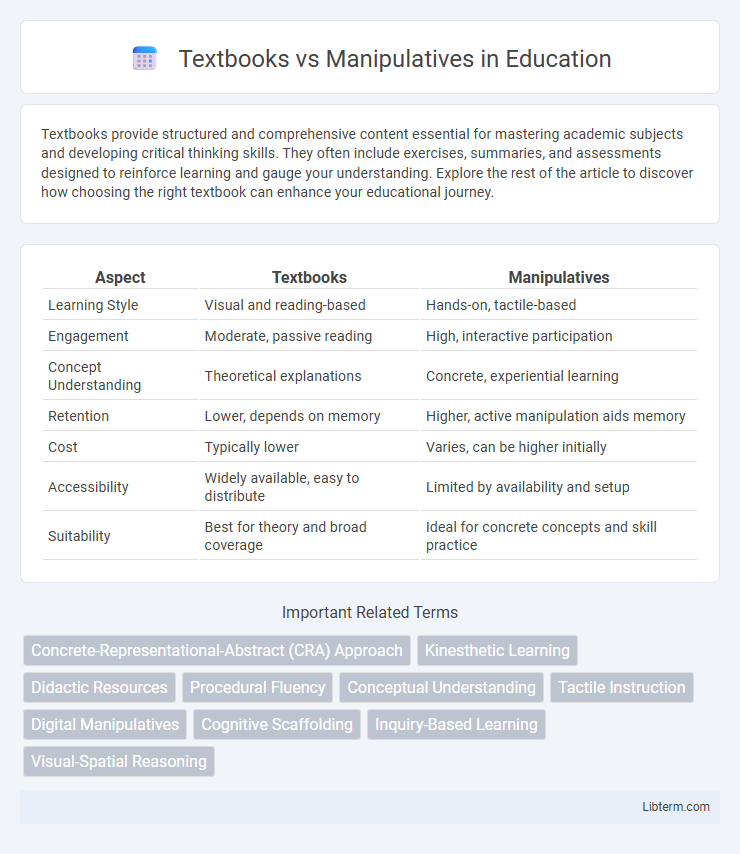Textbooks provide structured and comprehensive content essential for mastering academic subjects and developing critical thinking skills. They often include exercises, summaries, and assessments designed to reinforce learning and gauge your understanding. Explore the rest of the article to discover how choosing the right textbook can enhance your educational journey.
Table of Comparison
| Aspect | Textbooks | Manipulatives |
|---|---|---|
| Learning Style | Visual and reading-based | Hands-on, tactile-based |
| Engagement | Moderate, passive reading | High, interactive participation |
| Concept Understanding | Theoretical explanations | Concrete, experiential learning |
| Retention | Lower, depends on memory | Higher, active manipulation aids memory |
| Cost | Typically lower | Varies, can be higher initially |
| Accessibility | Widely available, easy to distribute | Limited by availability and setup |
| Suitability | Best for theory and broad coverage | Ideal for concrete concepts and skill practice |
Introduction to Textbooks and Manipulatives
Textbooks provide structured, comprehensive content designed to guide learners through curriculum standards with clear explanations and practice exercises. Manipulatives offer hands-on, tactile experiences that help students build conceptual understanding through physical interaction and visualization. Combining textbooks with manipulatives enhances cognitive engagement and supports diverse learning styles in educational settings.
Defining Textbooks in Education
Textbooks in education serve as structured, comprehensive resources that present curriculum-based content aligned with learning standards. They provide standardized information and exercises designed to facilitate theoretical understanding across diverse subjects and grade levels. These printed or digital materials ensure consistent delivery of educational concepts, supporting both teaching and assessment processes.
Understanding Manipulatives in Learning
Manipulatives are physical objects that enable hands-on learning, fostering deeper comprehension of abstract concepts by engaging multiple senses. Research shows that students using manipulatives often demonstrate improved problem-solving skills and retention compared to traditional textbook methods. Incorporating manipulatives in curricula enhances cognitive development and supports diverse learning styles through active exploration and interaction.
Cognitive Benefits of Textbooks
Textbooks provide structured content that enhances comprehension through logical progression and detailed explanations, promoting deep cognitive engagement. They facilitate the development of critical thinking and analytical skills by presenting complex theories and examples for reflective study. Well-designed textbooks integrate diagrams and summaries that support memory retention and facilitate connections between concepts.
Hands-On Advantages of Manipulatives
Manipulatives provide tactile and visual engagement that enhances comprehension of complex mathematical concepts, making abstract ideas more concrete for learners. Research shows students using manipulatives demonstrate improved problem-solving skills and retention compared to those relying solely on textbooks. These hands-on tools foster active learning and increase motivation by allowing learners to physically interact with the subject matter.
Comparing Engagement: Passive vs. Active Learning
Textbooks often promote passive learning by delivering information through reading and lectures, which can limit student engagement and retention. Manipulatives encourage active learning by allowing students to physically interact with concepts, fostering deeper understanding and critical thinking skills. Studies show that hands-on activities with manipulatives boost motivation and help students better grasp abstract ideas compared to traditional textbook methods.
Accessibility and Practicality in the Classroom
Textbooks provide structured content and comprehensive curriculum coverage, ensuring consistency in lesson delivery, while manipulatives offer hands-on learning experiences that enhance conceptual understanding through tactile interaction. Accessibility in the classroom varies as textbooks are easily distributed and utilized in diverse educational settings, whereas manipulatives require physical resources and space, which can limit their availability and practicality. Effective teaching balances both by integrating manipulatives for interactive engagement and textbooks for detailed information, adapting to students' needs and resource constraints.
Impact on Student Achievement and Retention
Manipulatives enhance student achievement by providing hands-on, experiential learning that improves conceptual understanding and long-term retention of mathematical concepts. Textbooks offer structured content and systematic practice but may result in lower engagement and less effective retention without interactive elements. Research indicates students using manipulatives show higher test scores and better problem-solving skills, reinforcing mastery beyond rote memorization.
Integrating Textbooks and Manipulatives for Best Results
Integrating textbooks and manipulatives enhances learning by combining theoretical knowledge with hands-on experience, which improves student comprehension and retention. Textbooks provide structured content and standardized information, while manipulatives offer tangible interaction that supports concept visualization and critical thinking. This blended approach promotes deeper understanding and accommodates diverse learning styles, yielding optimal educational outcomes.
Conclusion: Choosing the Right Educational Tools
Selecting the right educational tools depends on the learning objectives and student needs, with textbooks offering structured content and manipulatives providing hands-on interaction. Research indicates that combining both approaches enhances comprehension and retention by addressing diverse learning styles. Educators should evaluate curriculum goals to balance traditional materials with tactile experiences for optimal student engagement and achievement.
Textbooks Infographic

 libterm.com
libterm.com